Mac's Believe It Or Not!
by John McDougald
Reprinted from "Crown Jewels of the Wire", March 2001, page 20
The CD 106 Hemingray No.9 Story
1895 - 1955
The CD 106, Hemingray No.9 holds the record for the longest continuous
production of an insulator style by any single manufacturer. The Hemi-9 was
produced for approximately 60 years, from about 1895 until 1955, when it was
replaced by its more modem counterpart, the CD 107. Although it was never
manufactured in many of the exotic colors of its close relatives, the CD 145
H.G. Co, and the CD 162 H.G. Co. and Hemingrays, it still holds an important
place in the collecting hobby because of its longevity and for the variety of
embossings, embossing errors, and yes, colors that are part of its great
history.
This article is designed to provide an appreciation for two major aspects of
the Hemi-9: the variety of embossings that have appeared on this style, and the
variety of colors in which the Hemi-9 has been manufactured.
Since most of the embossing varieties appear only in aqua and it is hard to
distinguish subtle embossing differences, I have included photographs of all of
the embossing variations I have been able to acquire to date. Of the 37 known
embossings, 22 are pictured. They represent all of the major embossing changes
and some of the errors that have occurred in the engraving process.
Below is listed a chronology of the major embossing variations, along with
their dates of introduction. This information is based primarily on work done by
other researchers (e.g. N.R. Woodward) and some of my own suppositions. Since we
are dealing with history that is not fully documented, this represents my best
guess as to the chronology.
|
1.
|
(F-Skirt) HEMINGRAY /No 9 SB
|
|
|
Embossing [230]
|
|
|
Introduced ~ 1895
|
|
|
|
|
2.
|
(F-Skirt) HEMINGRAY /No 9
|
|
|
(R-Skirt) PATENT/MAY 2 1893 SDP
|
|
|
Embossing [250]
|
|
|
Related Embossings: [040] [050] [060] [210] [240] [260] [270] [280] [340] [350]
[360]
|
|
|
Introduced ~ 1895
|
|
|
|
|
3.
|
(F-Skirt) HEMINGRA Y /No 9
|
|
|
(R-Skirt) PATENTED/MAY 2 1893 SDP
|
|
|
Embossing [330]
|
|
|
Related Embossings: [290] [320]
|
|
|
Introduced ~ 1900
|
|
|
|
|
4.
|
(F-Skirt) HEMINGRAY /No 9
|
|
|
(R-Skirt) PATENTED SDP
|
|
|
Embossing [310]
|
|
|
Related
Embossing: [300]
|
|
|
Introduced ~ 1908
|
|
|
|
|
5.
|
(F-Skirt) HEMINGRAY SDP
|
|
|
Embossing [080]
|
|
|
Related Embossing: [070]
|
|
|
Introduced ~ 1910
|
|
|
|
|
6.
|
(F-Skirt) HEMINGRAY
|
|
|
(R-Skirt) No 9 SDP
|
|
|
Embossing [100]
|
|
|
Related Embossings:
[010] [090]
|
|
|
Introduced ~ 1910
|
|
|
|
|
7.
|
(F-Skirt) HEMINGRAY/MADE IN U.S.A.
|
|
|
(R-Skirt) No 9 SDP
|
|
|
Embossing [220]
|
|
|
Related Embossing: [030]
|
|
|
Introduced ~ 1919
|
|
|
|
|
8.
|
(F-Skirt) HEMINGRAY-9
|
|
|
(R-Skirt) MADE IN U.S.A. SDP
|
|
|
Embossing [130]
|
|
|
Related
Embossings: [020] [110] [120] [160] [170] [370]
|
|
|
Introduced ~ 1922
|
|
|
|
|
9.
|
(F-Skirt) HEMINGRAY-9/[Number]
|
|
|
(R-Skirt) MADE IN U.S.A. RDP
|
|
|
Embossing
[200]
|
|
|
Introduced ~ 1933
|
|
|
|
|
10.
|
(F-Skirt) HEMINGRAY-9/[Numbers and dots]
|
|
|
(R-Skirt) MADE IN U.S.A./[Number]
RDP
|
|
|
Embossing [180]
|
|
|
Related Embossing: [190]
|
|
|
Introduced ~ 1934
|
|
|
|
|
11.
|
(F-Skirt) HEMINGRAY-9
|
|
|
(R-Skirt) MADE IN U.S.A / [Numbers and dots] SDP
|
|
|
Embossing [140]
|
|
|
Related Embossing: [150]
|
|
|
Introduced ~ 1938
|
EMBOSSINGS FOR HEMINGRAY CD 106
I believe this is the first Hemi-9 embossing. This identical front embossing can be found on [250]
embossed insulators which were introduced in 1895. I think this embossing
represents a small run before the decision was made to add drip points to the
Hemi-9 along with the patent date on the back of the insulator.
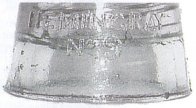
EMBOSSING [230]
Embossing [250] has four variations. This is the most common of the four
embossing styles that are found in embossing [250]. Notice the very uniformly
shaped letters that have a typewriter appearance. In particular, notice the
consistency in the formation of the numbers.

EMBOSSING [250]
(Stamped or Typed Embossing)
This is another fairly common embossing style for embossing [250]. Nearly all
of the Hemingray Blue Hemi-9's are found with this embossing style. Notice the
thickness, depth and contour of the letters, all very regularly formed.

EMBOSSING [250]
(Prismatic Embossing)
This is a less common style of embossing [250]. Notice the long tail on both
'9s' and the script '2'. Otherwise, very similar to the prismatic embossing.

EMBOSSING [250]
(Lazy '9' Style)
This is the least common embossing style for embossing [250]. This insulator
is very similar to [230] which leads me to believe that this embossing was a
rework of the smooth base mold. An underline has been added under the 'o', and
the patent date has been added to the back. However, this mold style is quite
different from the other [250]'s, with a much more gracefully formed skirt,
identical to the [230].

EMBOSSING [250]
(Large '9' Style)
This is an embossing error on the more common [250] embossing. Notice the
extra 'M' underneath the 'HE' in HEMINGRAY.

EMBOSSING [210]
This is a variation on embossing [250]. There are two things to notice on
this embossing. First, the '9' on the front embossing was made by turning a 'G'
upside down. Second, the first 'T' in PATENT is clearly embossed over an 'N'.

EMBOSSING [260]
This embossing is very similar to the Lazy 9 variation of embossing [250]
with the exception of the backward '9' in 1893.

EMBOSSING [280]
This is a variation on embossing [250]. This had to be the engraver's first
day on the job. The 'N' in HEMINGRAY is backward. The letters in PATENT get
successively larger, and the '2' is missing from the date. WOW!!

EMBOSSING [340]
The front half of this mold is a reworked rear half of embossing [250].
PATENT appears under HEMINGRAY, and MAY 2 1893 is clearly blotted out under NO.9
on the front skirt. This embossing is much more frequently found in Jade Green
Milk rather than Aqua.)

EMBOSSING [360]
This embossing was probably introduced about 1900 (this date is speculation)
as a minor modification of embossing [250]. This embossing is much less common
than [250] and is only found in Aqua, Hemingray Blue and some milky versions of
those colors.

EMBOSSING [330]
This is an embossing variation of embossing [330]. Apparently, the engraver
got tired and left the 'D' off PATENTED.

EMBOSSING [290]
This embossing was probably introduced about 1900 (this date is speculation)
as a minor modification of embossing [250]. This embossing is much less common
than [250] and is only found in Aqua, Hemingray Blue and some milky versions of
those colors.

EMBOSSING [310]
This embossing was probably introduced around 1910, at the same time the more
common [100] with No 9 on the back came into use. It is possible that they
represented an early run before the decision to engrave the back of the mold was
made.
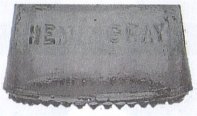
EMBOSSING [080]
This embossing was in common usage from about 1910 until 1919. It comes in a
nice variety of aqua and green shades.

EMBOSSING [100]
The dome number [010] has been found in these two variations.
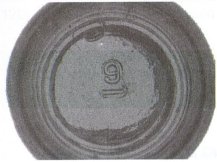
9 with an underline |
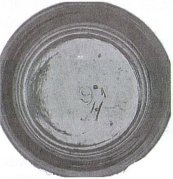
9 with no underline |

EMBOSSING [010]
The smooth base version of the [100] embossing is quite scarce. The one
pictured is the only representative I have in my collection. It also probably
only saw limited production before the sharp drip points were added.

EMBOSSING [090]
This embossing was introduced about 1919 and was in common use until it was
replaced by embossings [120] and [130] about 1922.

EMBOSSING [220]
The dome number on embossing [030].
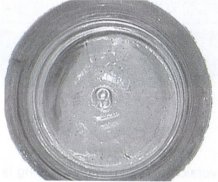

EMBOSSING [030]
This embossing, introduced in about 1922, is the more commonly seen embossing
using MADE IN U.S.A. However, the sharp drip point version is much less common
than the later round drip version [120]. Also, the colors are limited to Aquas
and Hemingray Blue

EMBOSSING [130]
This embossing was in common usage from the mid 1920's until 1933. This
period represents the transition from the use of sharp drip points to round drip
points. This embossing is well known for its 7-up Green color, among others.

EMBOSSING [120]
This is an embossing error variation of embossing [120]. Notice the backward
'N' in both HEMINGRAY and IN.

EMBOSSING [160]
This embossing was introduced in 1933, and it represents a minor modification
of embossing [120] with the addition of the '0' underneath the 'N' in HEMINGRAY.

EMBOSSING [200]
This embossing is known as the 0_4 series and is a minor modification to
embossing [200] which only had the '0' underneath the 'N' in HEMINGRAY. These
were introduced in 1934, and this particular insulator was made in 1935, as
indicated by the one additional dot following the 4.

EMBOSSING [180]
This embossing represents the last major embossing change made on the CD 106
Hemi-9. The numbers on the rear skirt indicate the mold (40) and the year of
manufacture (in this case, the mold was made in 1942 and the insulator was made
in 1946, which is indicated by the four additional dots following the 42).

EMBOSSING [140]
HEMINGRAY CD 106
EMBOSSING ODDITIES
|
The embossing with the largest space (so far) between the
No and the 9, just
over 3/4". |
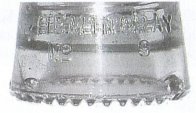 |
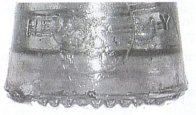 |
The worst blot-out resulting from a mold defect. Only the first and last two
letters of HE........AY are readable. |
|
The first vertical bar in the 'N' in PATENT is missing. |
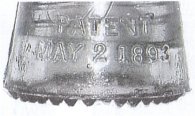 |
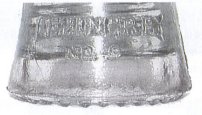 |
The word HEMINGRAY forms a chevron, with the 'H' and the 'Y'
significantly
longer than the central letters. Also, notice that the bottom of the 'H' and 'Y'
are cut at an angle to emphasize the curve. |
|
This odd italic appearing embossing may have occurred as a result of the
bottom portion of the insulator shifting as the plunger was inserted or removed.
The bottoms of the letters are 1/8" to the right of where they should be,
and the fault line is right where the ledge of the threading appears on the
skirt. |
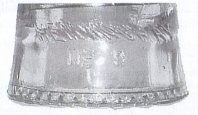 |
COLORS FOR HEMINGRAY CD 106
The second section of this article consists of color descriptions related to
the color insert and is designed to provide a relatively full color spectrum of
the Hemi-9 series. The embossing [xxx] precedes each of the color descriptions
and refers to the embossing index in the McDougald's Insulators -1999 Price
Guide.
7-UP GREEN
[120]
Embossing [120] only has two claims to fame as far as colors
go, and this is the most well known. The 7-up Green color has been popular
inside and outside the insulator hobby for a long time. One of the reasons these
are becoming harder to find is that a lot of them have found their way into the
hands of non-collectors because of the color.
The first three insulators show how increasing amounts of yellow green in the
glass batch creates a range of colors all the way from ice green to the classic
7-up green.
TWO-TONES [120]
The second color claim to fame of embossing [120] is the
two-tone insulator. There has been quite a bit of recent discussion on how
two-tone insulators were manufactured (obviously, not intentionally), but I am
not convinced by any of the suggestions put forth so far. It's still a mystery
as far as I am concerned.
Pictured is a Blue/Clear mix. Also available are a Light 7-up Green
predominating over Hemingray Blue, and an equal mix of 7-up Green and Hemingray
Blue.
HEMINGRAY BLUE [130]
Hemingray Blue, a vibrant blue color, has been
associated with multiple Hemingray-embossed pieces throughout their entire
product line.
GRAY [250]
Insulators with gray as the predominant color are quite rare in
any style by any manufacturer. Changes in lighting has a major impact on how
insulator colors appear, particularly these in-between colors like gray. The
piece pictured has a good deal of milk as part of the mix.
HEMINGRAY BLUE [250]
Hemingray Blue is a very underrated color in CD 106,
embossing [250] Hemingrays. The insulator on the left of this group of three is
the closest I have to a Hemingray Blue. It is more like the Hemingray Blue seen
in H.G. Co. embossed insulators rather than the brilliant Hemingray Blue seen in
the [130] representative.
Hemingray Blue pieces with increasing amounts of bubbles in the glass change
its look. The piece on the right is almost 100% bubbles.
JADE GREEN/MILK SWIRLS [250]
Turning to the second page of color photos, you
find two insulators which have a variety of factors influencing the colors,
including milky swirls, amber streaks and bubbles. When these factors are found
in combination in insulators, they defy color description.
To the right is a Hemingray Blue piece with a heavy amount of milk swirling.
I believe a Jade Blue Milk (solid jade) exists, but I have been unable to
acquire one to this point.
Next are two insulators that represent the range of colors that can be found
in the jade green family. The one on the left has light jade coloration while
the second one is a solid jade milk.
GREEN [250]
Green Hemi-9's in this embossing are the least common of all the
colors, much less common than even the purples. This group of four greens at the
bottom of the page represents a pretty good cross section of the available
colors. As with any color collection, you can never say you have them all.
From the end of the second row, the colors are Sage Green, Light Green, Dark
Yellow Green and Dark Green.
ICE COLORS [250]
On page 3 you see another group of underrated and under
appreciated colors. These near clear colors are quite rare compared to their
aqua counterparts. The colors assigned to these pieces are Aqua Tint, Light
Cornflower Blue and Off Clear (second row to the right).
PURPLE [250]
Purple is still one of the most popular colors, and the Hemi-9's
are no exceptions. This group of three insulators shows the range of colors
available in Purple.
The first is Light Lavender, followed by Lavender (2nd row left) and Dark
Purple. (Unfortunately we got the wrong picture placement on the color insert,
so refer to the cover for the Dark Purple representative).
- - - - - - - - - - - - -
At the bottom of page 3, you can see three examples of the flared skirt [250]
embossing. I believe these were the earliest [250] made because the hand-scribed
'9' is identical to the smooth-based [230] embossing. The colors are Bubbly
Aqua, Light Depression Glass Green and Yellow Green.
- - - - - - - - - - - - -
GRAY / PURPLE SWIRLS [250]
Many insulators that appear purple from a distance are not solid in color but
just heavily swirled with purple. That is the case with the two insulators at
the top of page 4. This swirling gives these pieces a Gray/Purple appearance.
For entertainment, you can try the Cool Whip trick. Take an empty Cool Whip
container (or other white plastic container) and fill it with water. Take a
light to medium purple insulator (Hemi-9's, Hemi 12's and CD 143 Canadian
Pacific's work best) and put it in the water. You will be amazed at the color
separation that becomes evident underwater that cannot be clearly seen when you
are just holding an insulator. Try it!!
GREEN & AQUA W / AMBER [100]
This is one of the few embossing styles
other than [250] that comes in a variety of colors. These two insulators are in
the green family. The one on the right of the top row is Aqua w/Amber Swirls.
You can see, as the blue aqua base color mixes with the amber streaks, how the
insulator takes on more of a green appearance, which is only natural if we
remember that mixing blue and yellow makes green. The color on the left end of
the 2nd row is Yellow Green.
THE FAKES
These five insulators have all been altered in some way to change their
original colors. They are part of this article to help collectors recognize
fakes. The first two pieces have been altered through radiation. The first was
originally clear and became the Light Amber after radiation. The second was 7-up
green and become Dark Olive Amber after radiation. The last three pieces have
been surface treated to change their colors. I believe they were all clear
originally. I'll call these colors Gold Carnival, Green Carnival and Gold
Plated. Don't be fooled by these FAKES!!!
WEIGHING INSULATORS [250]
It must have been a real boring day about five years ago when I noticed that
there was a substantial difference in the weight of the Hemi-9, embossing [250]
insulators in my collection. So, with my handy postal scale, I weighed all the
[250]'s in my collection (about 100 at the time). I discovered a huge variation.
The lightest weigh in at a mere 8.6 ounces, while the heaviest, loaded with
junk, weighed in at a hefty 12.1 ounces. Now you might think that this was a
useless exercise, but that heavy one weighs 40% more than the light one. If you
were the procurement expert at the Hemingray plant, how would you like to
explain an increase of 40% in materials usage without any increase in
production. A little more quality control on the mold making, please.
My specialty collection, Believe It
or Not!
might become yours someday.
Carefully look over those Hemi-9's so you don't overlook a rare one!
| 